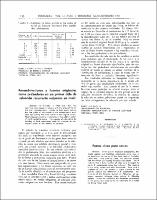| dc.contributor.author | Lozano Jimenez, Oscar R. | |
| dc.date.accessioned | 2025-08-27T20:22:36Z | |
| dc.date.available | 2025-08-27T20:22:36Z | |
| dc.date.issued | 1962-07-01 | |
| dc.identifier.uri | https://repositorio.catie.ac.cr/handle/11554/13839 | |
| dc.description.abstract | Three species, Erythrina poeppigiana, Gliricidia sepium and Erythrina costaricensis were used in an experiment on rooting of live fence posts at Turrialba, Costa Rica. Two planting dates, two diameter classes, and the effects of a rooting hormone were tested Results indicate that a large number of posts were damaged by cattle, E. costaricensis being less affected. The planting in the rainy season was more favourable Posts with a diameter of 6-12 cm. showed a higher survival in two species, without any difference in E. costaricensis. Ap-plication of the hormone showed no difference, an ap-parent negative influence being noticed in Gliricidia sepium It may be concluded that Erythrina costaricensis is the species best adapted to the conditions of Turrialba for living fence posts | es_ES |
| dc.format.extent | 3 | es_ES |
| dc.language.iso | es | es_ES |
| dc.publisher | Instituto Interamericano de Ciencias Agrícolas (IICA) | es_ES |
| dc.relation.ispartof | Turrialba Vol. 12, no. 3 | es_ES |
| dc.subject | Cerca viva||hedges||sebe||haie | es_ES |
| dc.subject | Planta||plants||planta||plante | es_ES |
| dc.subject | Árbol||trees||árvore||arbre | es_ES |
| dc.subject | Arbusto||shrubs||arbusto||arbuste | es_ES |
| dc.subject.other | Sede Central | es_ES |
| dc.title | Postes vivos para cercos | es_ES |
| dc.type | Artículo | es_ES |
| dc.identifier.status | openAccess | es_ES |


